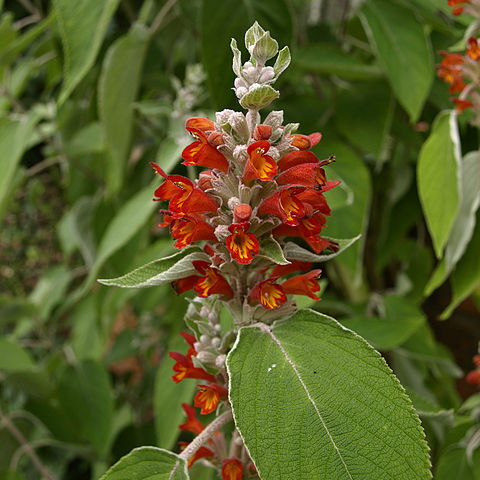Shrubs 1-2(-4.5) m tall, erect or pendent; branches rust colored tomentose. Petiole 1-2 cm; leaf blade ovate to ovate-lanceolate, 7-11 × 2.5-4.5 cm, gradually reduced toward apex, papery, rust colored stellate tomentose, base rounded, margin crenulate, apex acuminate. Verticillasters 6-20-flowered, in fascicled, capitate, or elongated inflorescences on lateral branches, ± stellate hairy, surrounded by bracteoles; floral leaves similar to stem leaves. Pedicel less than 1 mm. Calyx ca. 6 mm, stellate hairy, inconspicuously 10-veined; teeth straight, broadly triangular, ca. 1 mm. Corolla orange-red to scarlet, 2-2.5 cm, sparsely stellate hairy; tube 1.7-2.3 cm, curved outward, mouth dilated; upper lip ovate, slightly 2-lobed, slightly galeate; lower lip spreading, lobes ovate. Ovary glandular. Nutlets oblanceolate. Fl. Aug-Nov(-Dec), fr. Nov-Jan.
More
A shrub. It grows to 3 m high. The stems are square in cross section. The leaves are opposite. They are 3.5-16.5 cm long by 2.5-7.5 cm wide. They are oval and taper to the tip. There are teeth along the edge. They have a few hairs. The base is rounded or heart shaped. The flowers are red or orange and in spikes in the axils of leaves or at the ends of branches. The fruit is a nutlet. It is oblong. The tip is expanded into a wing.
It is a warm temperate plant. It grows in Nepal between 1000-2600 m altitude. It grows in open rocky places. It needs well-drained soil in full sun. In China it grows in stony and grassy hillsides between 1400-3000 m altitude. It is resistant to frost but sensitive to drought. It suits hardiness zones 8-9. Melbourne Botanical gardens. In Yunnan.

